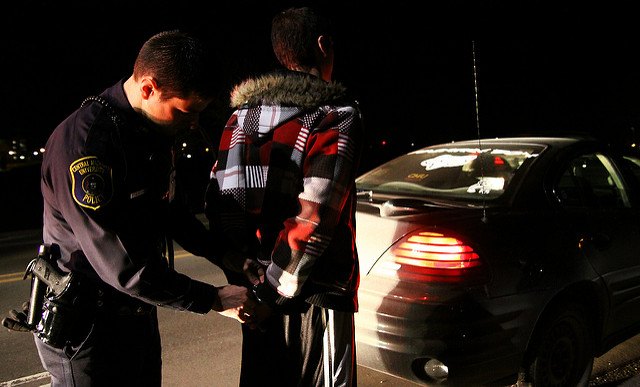Looming Legal Weed Sparks Roadside Worries in Canada

Canada’s oh-so-green federal government sure isn’t concerned about one form of air pollution — clouds of marijuana smoke. With the country’s cities already infused with the tell-tale odor of wacky tobaccy, legislation has been tabled to make possession of the drug legal, perhaps by as early as July 2018.
Great news for grass aficionados, but a troubling turn of events for road safety advocates. The jury’s out on whether Canada’s law would spark an uptick in drugged driving, but the proposed methods of testing — and convicting — weedy drivers has raised other concerns. One group has a problem with the Great Green North’s strategy to root out baked motorists.
It would seem the Canadian government is entering the wild and woolly world of weed with a reasonable degree of caution.
On the same day as the legalization legislation, the government tabled another bill targeting impaired drivers. The new measures will “better deter and detect drug-impaired driving,” the government claims, and would see motorists hand over two types of bodily fluids for testing during a roadside stop. Like booze, the bill would set legal limits to the amount of THC in a driver’s bloodstream.
While police officers will still be able to use their judgement to detect impairment — and provide opinion evidence in court — the motorist’s blood and saliva will likely seal their legal fate. In some U.S. jurisdictions, plenty of doubt has attached itself to the results of saliva swab tests. A blood test is meant to overcome the inaccuracies present in the first test.
According to the Canadian proposal, “Qualified technicians would be able to take blood samples from a driver without a doctor’s oversight, allowing for testing sooner after a person is pulled over.” This is supposed to increase the accuracy of the test and free up scarce healthcare personnel. However, the Canadian Automobile Association (CAA) has voiced its worry over the testing.
The new law “would require a positive blood test within two hours in order to get a conviction,” the association stated in a recent release. “Evidence from U.S. jurisdictions is that it often takes longer than two hours to complete the process, and also requires the presence of a trained technician to take the sample, putting a tough burden on law enforcement and raising questions about how workable the provision will be.”
After several states legalized marijuana, a study showed levels of bloodstream THC didn’t correspond with a driver’s level of impairment. Because of this, the American Automotive Association has advocated for observation-based impairment detection, where trained officers analyze a number of physiological and behavioral indicators.
It sounds like Canuck cops might be given that say, though it’s doubtful that a driver with blood-tested THC levels above the legal maximum would get a pass, regardless of how sharp they were while standing on the roadside. Another concern is the training promised for police forces.
“While the government committed today to making more money available to train police in drug recognition and to acquire testing devices, it didn’t say how much or when it will be available,” CAA stated. It has the same concern about the limited money promised for public information campaigns.
Don’t expect the so-called “Prince of Pot” Marc Emery to make the job of the government (or CAA) any easier. The marijuana activist and high-profile supporter of Canadian Prime Minister Justin Trudeau — who ran on the promise to legalize — just told the media that smoking weed makes you a better driver.
[Image: Jeffrey Smith/ Flickr ( CC BY-ND 2.0)]

More by Steph Willems
Latest Car Reviews
Read moreLatest Product Reviews
Read moreRecent Comments
- Redapple2 I think I ve been in 100 plants. ~ 20 in Mexico. ~10 Europe. Balance usa. About 1/2 nonunion. I supervised UAW skilled trades guys at GM Powertrain for 6 years. I know the answer.PS- you do know GM products - sales weighted - average about 40% USA-Canada Content.
- Jrhurren Unions and ownership need to work towards the common good together. Shawn Fain is a clown who would love to drive the companies out of business (or offshored) just to claim victory.
- Redapple2 Tadge will be replaced with a girl. Even thought -today- only 13% of engineer -newly granted BS are female. So, a Tadge level job takes ~~ 25 yrs of experience, I d look at % in 2000. I d bet it was lower. Not higher. 10%. (You cannot believe what % of top jobs at gm are women. @ 10%. Jeez.)
- Redapple2 .....styling has moved into [s]exotic car territory[/s] tortured over done origami land. There; I fixed it. C 7 is best looking.
- TheEndlessEnigma Of course they should unionize. US based automotive production component production and auto assembly plants with unionized memberships produce the highest quality products in the automotive sector. Just look at the high quality products produced by GM, Ford and Chrysler!


































Comments
Join the conversation
Pull over a young male in a Grand Am, there's a pretty good chance you'll find something.
My experience, many years ago, was that many 'stoners' typically drove pretty poorly whether or not they were high at the time. People who were really baked, would drive excessively carefully and slowly, to the point of being a danger to others as well as being very obviously impaired. People who functioned at a moderate level of high-ness, the average person would not be able to tell a difference.